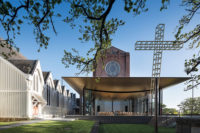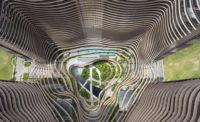Some conventions beg for a challenge. Case in point: a fabric warehouse in Auckland, New Zealand, where visitors stride up a concrete ramp from a street on the central city's light-industrial fringes. Passing through crystalline glass doors, they find themselves not in a dull reception area leading to anonymous offices, but among colorful bolts of gorgeous cloth—all while loading and deliveries carry on hectically around them. The architects responsible for this upending of typical warehouse hierarchy say hiding the fabrics from view was never an option. “A traditional office warehouse is highly divided,” says Tim Hay, cofounder of Fearon Hay Architects, “but here there's a beautiful texture and visual scene. Why would you want to compromise that? It's lovely to be in this room and be able to survey the whole space.” This embrace of openness instead of segregation at Wall Fabrics, a wholesaler of high-end fashion textiles, is bringing welcome benefits, according to the firm's owner, Roger Wall. “I think everyone's interested in this space, which changes things—everyone's attitude has lifted. It's a simpler place to work,” he says.
The 1970s building, made of precast concrete slabs interspersed with steel-framed windows and topped with a gently pitched roof, was purchased almost two years ago for the company's combined warehouse and office. Wall told Hay and his co-designer, Jeff Fearon, that the 16,000-square-foot space, blessed with abundant daylight, needed to hold thousands of yards of fabric as well as provide shared facilities for the administrative staff and warehouse personnel. Customers visit the warehouse to inspect new stock, an ever-changing vista of color and pattern. At the same time, fabrics are dispatched from here to the company's Fabric Store retail outlets in New Zealand, Australia, and Los Angeles.
Determined to maintain the warehouse's sense of openness, Fearon and Hay opted for the most delicate separation of zones, an ethereal glass wall punctuated by rosewood- trimmed panels that pivot open. Some, with handles, serve as actual doors. This glass wall keeps warehouse noise out of the office yet maintains a strong visual connection. It appears to be weightless, supported by a blackened steel-plate transom hung from a beam and fastened to the office ceiling with a row of steel cables. “The wall feels like a suspended glass ribbon,” Hay says. “The reflections break up the mass of it, and its doors are like gills that allow air to move.”
The wall is topped with white plasterboard that rises to the ceiling on the warehouse side. The glass panels don't extend all the way along the interior, however. They pull up short of the building's edge to lend a greater sense of spaciousness to a shared kitchen and dining area, where Wall hosts Friday lunches for the whole staff. A self-confessed fanatic for mid-20th-century furniture and a sleuth at sniffing out a bargain, Wall has outfitted the offices with an arsenal of Eames furniture that he purchased cheaply over a decade ago from American Express, when the credit-card firm was moving its Auckland operations. He is also an enthusiastic art collector, displaying works by prominent New Zealand artists democratically throughout the warehouse and office zones. He pushed Fearon and Hay to add a solid suspended wall at the end of the office area for hanging art, but even this insertion emphasizes the porousness of the spaces, with the wall stopping short of the floor, connecting with it via a glass panel.
The architects established their firm 15 years ago and gained attention for designing modernist residences in isolated locations, such as the Shark Alley House on Great Barrier Island, a four-hour ferry journey from Auckland. More recently they have completed a slew of civic and commercial projects. One of them, the conversion of an abandoned century-old cinema in downtown Auckland into an office and restaurant complex, recently won the New Zealand Architecture Medal, the highest annual honor bestowed by the New Zealand Institute of Architects. Fearon and Hay were praised for their unfussy retention of many elements of the original building, and their work in the fabric warehouse reflects a similarly generous embrace of its innate character. Its unrefined concrete floor has been retained, and its ceiling beams remain exposed. Apart from the big gesture of the insertion of the glass wall, Fearon and Hay have made no significant changes to the structure.
The project did, however, include the design of one private office at the end of the warehouse, where Wall takes meetings and makes morning and evening phone calls to international associates. It's a thoroughly pleasant but under-utilized room, as Wall prefers to spend his day among his staff and the many couriers, customers, and general visitors who bustle in and out each day. In Wall Fabrics' new premises, the warehouse floor has turned out to be the boss's favorite place.
Jeremy Hansen is the editor in chief of HOME, a residential architecture magazine based in Auckland, New Zealand.
Size: 16,000 square feet
Cost: withheld
PeopleArchitect: Personnel in architect's firm who should receive special credit: Interior designer: Engineer(s): General contractor: Photographer(s): CAD system, project management, or other software used: AutoCAD |
ProductsExterior cladding Roofing Windows Glazing Hardware Pulls: Security devices: Interior finishes Paints and stains: Special interior finishes unique to this project: Dornbracht tapwear Custom joinry & metalwork Boffi ceiling fans Furnishings Lighting Task lighting: Conveyance |








Post a comment to this article
Report Abusive Comment